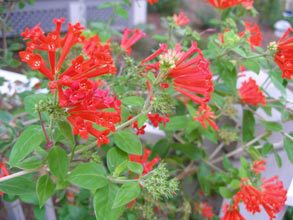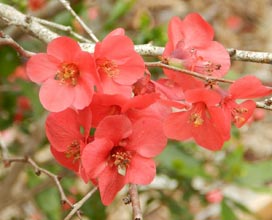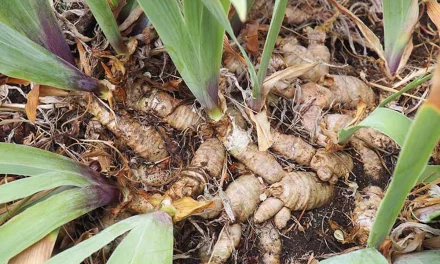 And I say Solanum Lycospurnum. Well not really, can you imagine the funny looks I would get in the grocery store? There are good reasons for learning the botanical names for plants however.
And I say Solanum Lycospurnum. Well not really, can you imagine the funny looks I would get in the grocery store? There are good reasons for learning the botanical names for plants however.
Last Fall, a friend visiting from Chile walked around my garden and commented on the colorful leaves of what is commonly known here as a Japanese Maple tree. She asked if we called it Acer like they did in her homeland. More recently a friend who grew up in Europe made reference to my Acer as we walked in the garden. She too asked if I called it Acer. Had I not known the genus of the Japanese Maple was Acer, pronounced AY-ser, we would not have been on the same page.
Common names for plants might be different in different parts of the country. Growing up, my parents referred to a Rose Campion as Dusty Miller. Imagine my surprise when I learned that Artemisia, Centaurea, Jacobaea maritima, Senecio and several others are also called Dusty Miller. In some parts of the country Turk’s Cap refers to a Lilium superbum. Here in the south Turk’s cap is a shrub, Malvaviscus, in the hibiscus family. Other commons names for that one are Drummond Wax Mallow, Texas Mallow, Mexical Apple, Red Mallow, May Apple, Bleeding Heart. Seriously? May Apple and Bleeding Heart are also names for Podophyllum, a woodland plant and Dicentra, a garden perennial usually grown in cooler climates. Bleeding Heart is also the common name for a vine, Clerodendron thomsonsii.
In addition to being very specific to individual plants, often the botanical name tells us something about the plant. Hemerocallis, for what we call a day lily, is taken from the Greek words “hemera” for day and “kallos” for beauty. As to how to pronounce those long names – who cares? If it is important to you, do check out the Fine Gardening magazine pronunciation guide. http://www.finegardening.com/pronunciation-guide
Enough Latin, its June and its beautiful outside! The Caladiums I planted this spring are lighting up a shady corner of the garden. The gardenias are perfuming the air and the roses, which loved the cold winter, are outdoing themselves this year. We must have had the perfect weather conditions for them. The Siam Tulips, Curcuma alismatifolia, are in full bloom and are attracting a lot of pollinators. It seems like each individual flower has a fat bee in it. I cut back my Bouvardia ternifolias this spring to make the plants fuller. They are just now flowering again and the hummingbirds and a Tiger Swallowtail have already discovered them. I try to always keep something that blooms with red tubular flowers flowering for them. Years ago I planted some Asiatic lilies but I never saw them bloom because the deer always devoured them early in the year. This year they bloomed for the first time and they were absolutely beautiful and such a surprise. There is some utility excavating going on in my neighborhood and it seems to have scared the critters away from the garden.
While driving along Rt. 21 I noticed a field of wildflowers in one of those special places protected by the Beaufort County Open Land Trust. There was a mass of blooming Parrot Gladiolas, Gladiolus dalenii, that caught my eye. These plants with their bright orange flowers are native to South Africa but have naturalized here. They have copious amounts of nectar and they are pollinated by songbirds.
I don’t usually plant annuals but I have a small spot that needed some color. The area gets morning sun so I am trying Sun Patiens, Impatiens hawkerii, a variety of impatiens that is bred for full sun, heat and humidity. Their bright, almost fluorescent colors really caught my eye at the Garden Center. I’ll report back and let you know how they perform in Lowcountry sun, heat and humidity.
Our pleasant Spring is about over, it is time to keep an eye on the moisture in the soil. Plants will do best with infrequent but deep watering in the hot weather. You want to encourage the roots to go deep where the soil is cooler. Besides being thirsty our plants are hungry. They use up fertilizers quickly in the heat but too much at one time can burn the roots. Light fertilization, half strength if using liquid, will be good and always apply it either early or late in the day, never in full sun. Keep an eye out for pests and remember, a good spray of water from your hose on a regular basis works well to prevent infestations in the first place.
The Solanum Lycospernum (see the title) I planted a month ago is full of fruit. If I can keep the squirrels away until they ripen we’ll have lots of BLTs here. Nothing says summer more than BLTs.
Don’t forget the Garden A Day tours, June 8th – 12th. I’ll be at the Ban’s garden on Thursday; be sure to stop by and say hello.








